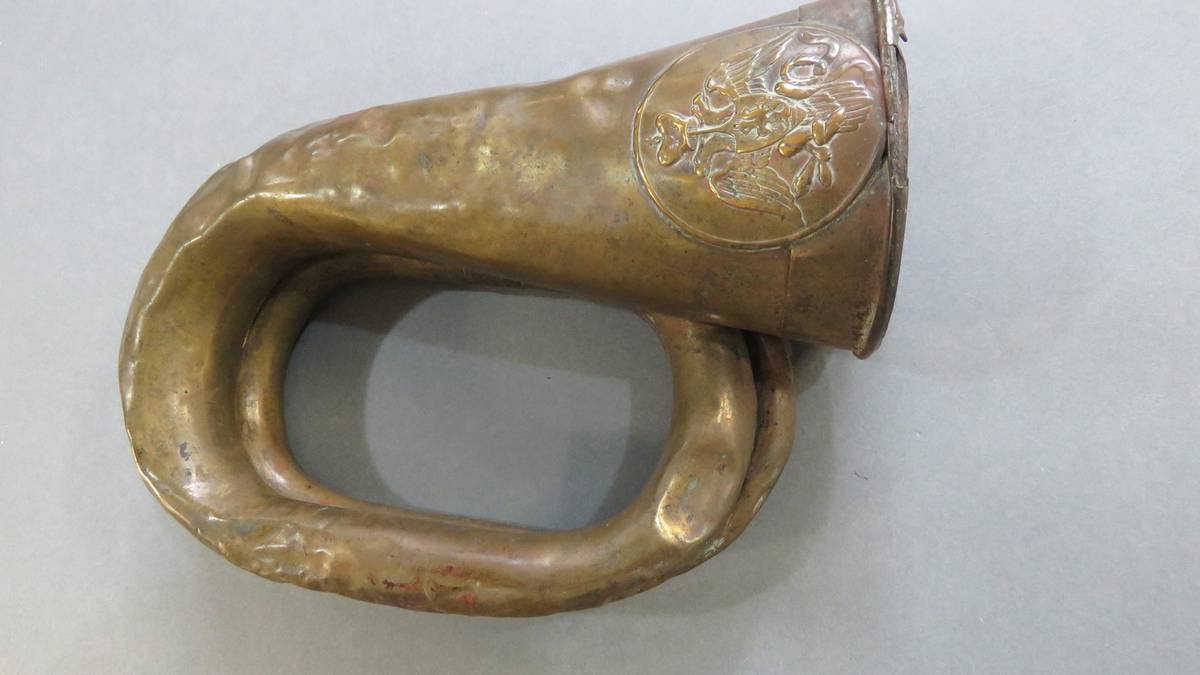The bugle has links to Glenbervie as Sir Robert resided here after he retired from his military career. This surprising local link helps foster a connection with Ukraine.
It can be difficult to connect with large world events because they can seem distant and abstract.
But objects help to personalise history by telling individual experiences through tangible objects. This personalisation of history helps counter the dominant national narrative of international events. History materialises in the object, and it does so in this Russian bugle (1964/6/18).
The bugle has the Russian military cockade embossed on it. The cockade consists of a double-headed eagle clutching a laurel wreath with a large crown hovering above, and centred is a pictorial depiction of St George slaying the dragon.
The bugle was present at the Battle of Sevastopol, the beginning of the end of the Crimean War (1853-1856). It is said a dying Russian soldier offered his bugle to the Scotsman, Sir Robert Andrews McKenzie Douglas, in exchange for some water following the battle.
/cloudfront-ap-southeast-2.images.arcpublishing.com/nzme/OLC4PYJZ2V4LZUEO3LAGDNCHLQ.jpg)
The bugle has links to Glenbervie as Sir Robert resided here after he retired from his military career. This surprising local link helps foster a connection with Ukraine.
War bugles are used to emit sound above the din of warfare. The blare of the bugle can communicate different messages, whether to attack, retreat or mourn.
The Battle of Sevastopol was the final chapter in the Crimean War. It was a hard-fought battle that lasted close to a year. Several attempts were made to take the city during that time.
The numerous dents in the bugle indicate the struggle and hardship of this conflict. There were many casualties from the Crimean War ̶ over 500,000 people lost their lives, the initial owner of the bugle being one of them. It is a tragic story, but not an uncommon one. Battlefield exchanges like this often occur.
Sir Robert Andrews McKenzie Douglas was posted to the 57th Middlesex Regiment, nicknamed “the Die Hards”. After Crimea, the regiment went on to Yemen, then India and on to New Zealand.
The 57th Regiment was involved in the New Zealand Wars, firstly in Taranaki and then in Whanganui.
In 1866, Sir Robert was involved in an attack on the Hauhaus. The Hauhaus were a religious sect founded and led by the prophet Te Ua Haumēne (Te Āti Awa). Some followers turned to violent resistance to fight land sales and confiscations.
It wasn’t until after the birth of his son, Robert jnr, that he and his wife, Eleanor Louisa (née Liffiton) moved to Whangārei.
They bought a large plot of land to the northeast of Whangārei Falls. Sir Robert named it Glenbervie, after a town in Scotland on the east coast between Dundee and Aberdeen.
Sir Robert was the 3rd Baronet of Glenbervie, and so this name was a familial link, given he decided to stay on in New Zealand after his regiment returned to the UK. This bugle tells stories of local and international significance. It is timely to reflect on Crimean history as we watch in horror as Putin continues his aggressive invasion of the Ukraine.
Ashleigh McLarin is the exhibitions curator at Whangārei Museum




